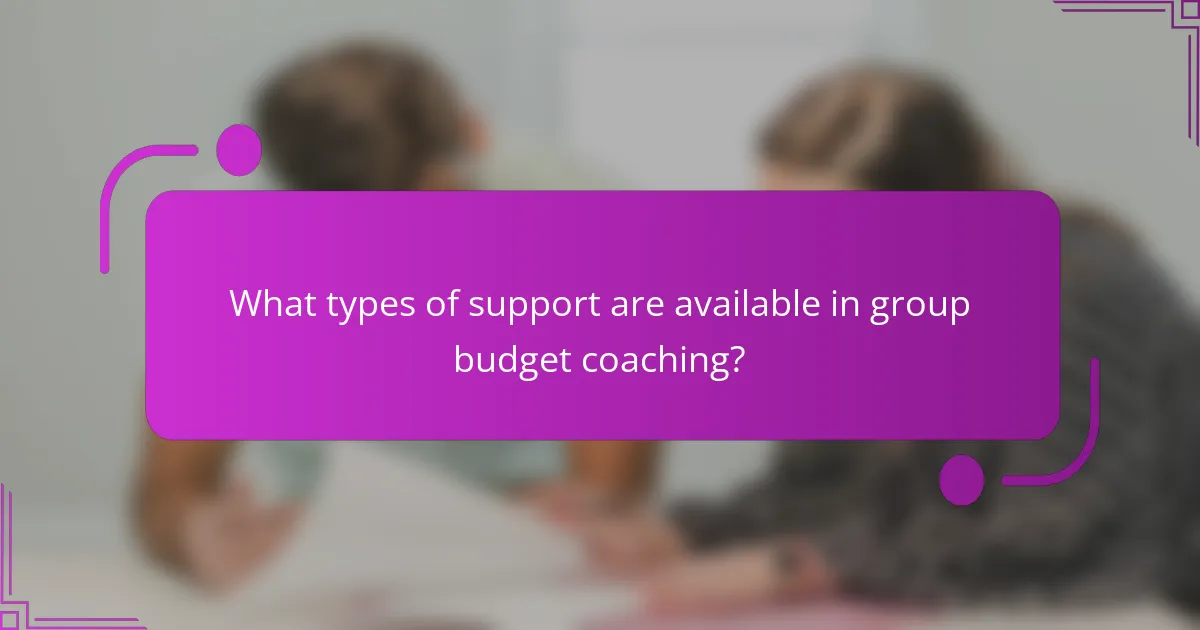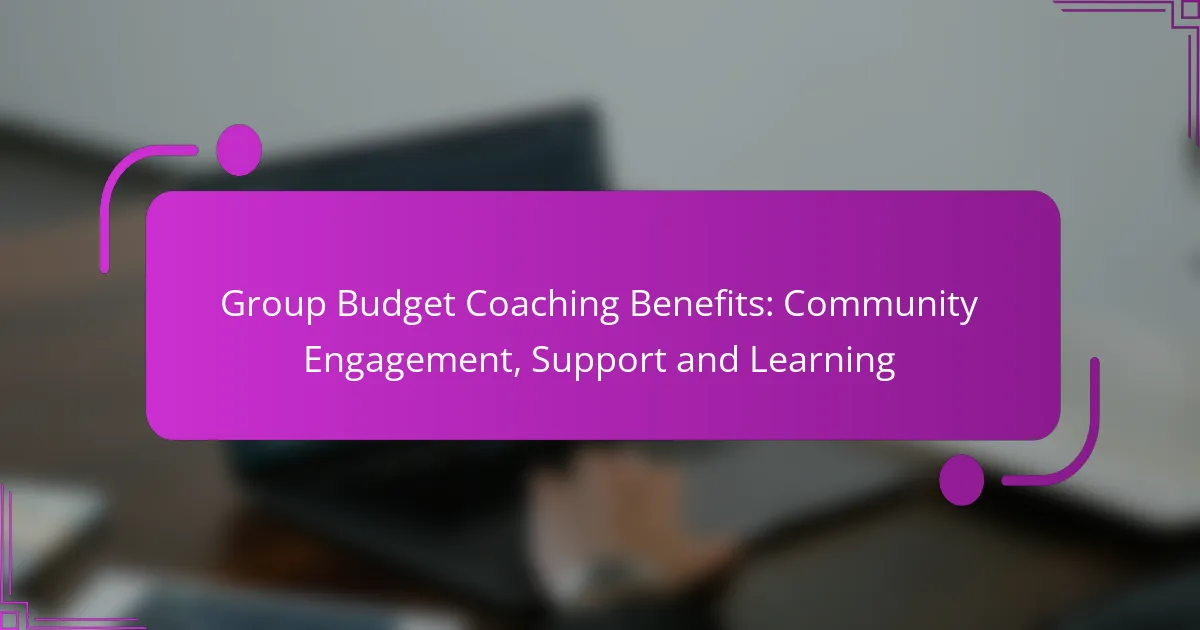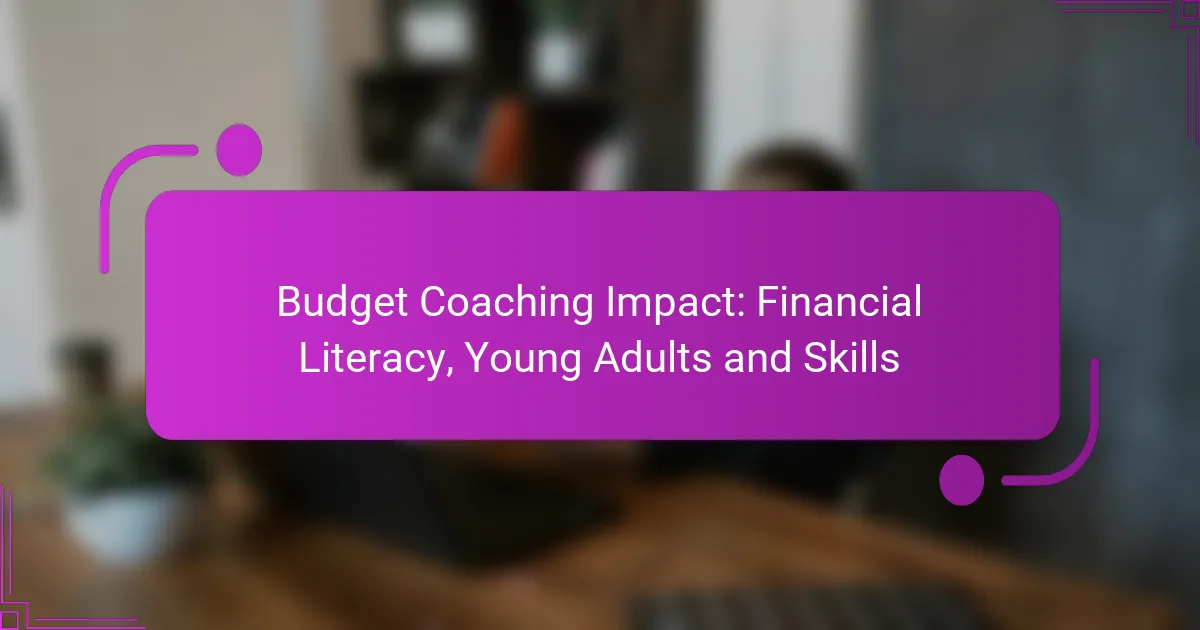Group budget coaching provides a unique opportunity for individuals to engage with their community while enhancing their financial skills. By participating in a collaborative environment, members benefit from shared experiences, diverse perspectives, and expert guidance, all of which contribute to improved budgeting practices and financial literacy.

What are the benefits of group budget coaching?
Group budget coaching offers several advantages, including enhanced community support, increased accountability, and opportunities for shared learning. Participants can benefit from collective experiences and diverse perspectives, ultimately improving their financial literacy.
Enhanced community engagement
Group budget coaching fosters a sense of belonging and community among participants. Engaging with others who share similar financial goals creates a supportive environment where individuals feel motivated to participate actively.
This engagement can lead to stronger relationships and networks, which are valuable for sharing resources and tips. For example, members might organize group challenges or events that further enhance their commitment to budgeting.
Increased accountability
Being part of a group increases accountability as members share their financial goals and progress with one another. This social pressure can encourage individuals to stick to their budgets and make informed financial decisions.
For instance, regular check-ins can help participants track their spending and savings, making it less likely for them to stray from their financial plans. Setting group goals can also enhance this accountability, as everyone works towards a common target.
Shared learning experiences
Group budget coaching provides a platform for shared learning, where participants can exchange strategies and insights. Learning from others’ successes and challenges can offer practical solutions that individuals might not have considered on their own.
Workshops or discussions on specific budgeting techniques, such as the 50/30/20 rule, can be particularly beneficial. Participants can share their experiences with different methods, helping each other refine their approaches to managing finances.
Access to diverse perspectives
In a group setting, individuals gain access to a variety of perspectives on budgeting and financial management. Different backgrounds and experiences can lead to innovative ideas and strategies that might not be evident in a solo approach.
This diversity can help participants understand how cultural or socioeconomic factors influence budgeting decisions. For example, someone from a different financial background may introduce unique budgeting tools or apps that have proven effective for them.
Improved financial literacy
Group budget coaching can significantly enhance participants’ financial literacy. Through discussions and shared resources, individuals can learn about essential topics such as saving, investing, and debt management.
Regularly engaging with financial concepts in a group setting can reinforce understanding and retention. Participants might also benefit from guest speakers or workshops that cover specific financial topics, further boosting their knowledge and confidence in managing money.

How does community engagement improve budgeting skills?
Community engagement enhances budgeting skills by fostering collaboration and shared learning among participants. When individuals come together to discuss their financial strategies and challenges, they gain diverse perspectives and practical insights that can lead to better budgeting practices.
Supportive environment for sharing
A supportive environment encourages individuals to openly share their budgeting experiences without fear of judgment. This openness allows members to discuss their successes and setbacks, creating a safe space for learning and growth.
Participants can exchange tips on managing expenses, saving strategies, and effective budgeting tools. For instance, someone might share a budgeting app that has helped them track their spending more efficiently, benefiting the entire group.
Motivation through peer interaction
Peer interaction serves as a powerful motivator in group budgeting coaching. When individuals see others making progress, it can inspire them to stay committed to their own financial goals. This collective motivation can lead to a more disciplined approach to budgeting.
Setting group goals, such as saving a certain amount by a specific date, can further enhance motivation. Regular check-ins allow members to celebrate milestones together, reinforcing positive behaviors and accountability within the group.

What types of support are available in group budget coaching?
Group budget coaching offers various forms of support, including expert guidance from coaches, peer support networks, and resource sharing among members. These elements work together to create a collaborative environment where individuals can improve their budgeting skills and financial literacy.
Expert guidance from coaches
Coaches in group budget coaching provide specialized knowledge and strategies tailored to the group’s needs. They help participants set realistic financial goals, develop effective budgeting techniques, and navigate common financial challenges.
For instance, a coach might introduce participants to the 50/30/20 rule, which suggests allocating 50% of income to needs, 30% to wants, and 20% to savings. This structured approach can simplify budgeting for many individuals.
Peer support networks
Peer support networks are a vital aspect of group budget coaching, fostering a sense of community among participants. Members share their experiences, challenges, and successes, which can motivate and inspire others to stay committed to their financial goals.
Regular group meetings encourage accountability, allowing members to discuss their progress and seek advice. This collaborative atmosphere can significantly enhance the learning experience and help individuals feel less isolated in their budgeting journey.
Resource sharing among members
Resource sharing is another key benefit of group budget coaching, as members can exchange tools, templates, and tips that have worked for them. This collaborative sharing can lead to discovering new budgeting apps, financial planning worksheets, or investment strategies that others have found effective.
For example, one member might share a budgeting spreadsheet that tracks expenses and savings, while another could recommend a local workshop on financial literacy. Such exchanges enrich the overall experience and provide practical resources that can be immediately applied.

How can group budget coaching enhance learning?
Group budget coaching enhances learning by fostering a collaborative environment where participants can share experiences and strategies. This collective approach allows individuals to gain diverse perspectives and practical insights into effective budgeting practices.
Workshops and seminars
Workshops and seminars provide structured learning experiences that focus on specific budgeting topics. These sessions often include expert-led discussions, interactive activities, and Q&A segments that encourage participant engagement. Attendees can expect to learn about budgeting tools, financial planning, and effective money management techniques.
Consider participating in workshops that cover essential skills such as creating a budget, tracking expenses, and setting financial goals. These sessions can range from a few hours to several days, depending on the depth of the material covered.
Real-life case studies
Real-life case studies illustrate practical applications of budgeting concepts, making them relatable and easier to understand. Participants can analyze different financial scenarios, learning how others have successfully managed their budgets or overcome financial challenges.
Engaging with case studies allows individuals to identify common pitfalls and effective strategies. For instance, examining a case where a family reduced their expenses by 20% through careful planning can inspire similar actions in participants’ own lives.
Collaborative problem-solving
Collaborative problem-solving encourages group members to work together to tackle budgeting challenges. This approach not only enhances learning but also builds a sense of community among participants. By sharing their unique experiences, individuals can brainstorm solutions and develop actionable plans.
To maximize the benefits of collaborative problem-solving, consider forming small groups to discuss specific budgeting issues. This can lead to the development of personalized strategies that cater to each member’s financial situation, making the learning process more relevant and impactful.

What are the prerequisites for joining a group budget coaching program?
To join a group budget coaching program, participants typically need a willingness to engage and a basic understanding of budgeting concepts. These prerequisites ensure that everyone can contribute to and benefit from the group dynamic effectively.
Willingness to participate
A strong willingness to participate is crucial for success in a group budget coaching program. This means being open to sharing personal financial experiences, asking questions, and collaborating with others. Active engagement fosters a supportive environment where participants can learn from each other.
To enhance participation, consider setting personal goals for what you want to achieve through the program. This could include reducing expenses, saving for a specific purchase, or improving overall financial literacy. Sharing these goals with the group can motivate both you and your peers.
Basic understanding of budgeting
Having a basic understanding of budgeting is essential for participants in a group budget coaching program. This includes familiarity with concepts such as income, expenses, savings, and financial goals. Understanding these elements allows participants to engage meaningfully in discussions and activities.
If you’re new to budgeting, consider reviewing fundamental resources or tools before joining. Simple budgeting methods, like the 50/30/20 rule, can provide a solid foundation. This rule suggests allocating 50% of your income to needs, 30% to wants, and 20% to savings and debt repayment, making it easier to grasp budgeting principles.



